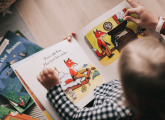When it comes to uncovering children’s views and interests, and using them to guide the
opportunities we provide, many of us have a lot to learn, says Tim Kahn…
I thought I knew all there was to know when it came to listening to young children, until in 2009 I embarked on my first project in that field. It was while I was working at the Pre-school Learning Alliance, and it involved consulting with young children (under-fives) and adults. You may wonder how you ask such young children for their opinions because often they cannot tell you clearly in one-on-one interviews, and nor will they sit in focus groups, unlike many adults.
What followed was for me a journey into a new world – and I suspect it will be new for many others. As Judy Miller, an expert on listening to young children and lead trainer for listening courses run by the Early Childhood Unit at the National Children’s Bureau, puts it: “Practitioners have, over the years, improved the extent to which they are listening to children” [but] “setting policies, recruitment, health and safety, purchase of equipment and, to some extent, routines of the day are still largely determined by adults and by wider agendas.”
During the project I came across the Mosaic approach for listening to young children (Clark and Moss, 2001). Recognising that young children, including pre-verbal ones, often cannot tell you their views in a direct way, this approach elicits their views through other methods. Children are encouraged to use cameras and make drawings and their own pictorial maps (with images of things that are important to them); discussions are held with them, and observations and interviews with adults (both practitioners and parents) are carried out – recognising that adult perspectives can be used to build a better understanding of young children’s experiences and opinions. As its name suggests, it uses a ‘mosaic’ of approaches to enable young children to express their views.
I also learned about Hart’s ladder of the quality of children’s participation. This uses the image of a ladder, suggesting that each rung represents a new level of children’s participation. The bottom of the ladder reflects an environment in which children play little or no part in decision-making, whereas the top (eighth) rung of the ladder reflects shared decision-making between adults and children. Each rung in between represents an intermediate level of participation. So, for example, gathering children’s views as to what they would like to see in their new outdoor play area, as I discovered one nursery in Newcastle doing, represents a question at the top of the ladder.
I discovered, too, that listening to and consulting with children was a rights issue. Most of the work in this field is based on Articles 12 and 13 of the UN Convention on the Rights of the Child, which states that “due weight” should be given to the views of any child who is capable of forming views (Article 12) and recognises children’s right to express their ideas and be given information in different ways (Article 13).
I got involved in YCVN, which sadly no longer exists as a funded network (though the NCB’s Early Childhood Unit is continuing the work – email .(JavaScript must be enabled to view this email address) for more information). This held termly meetings around the country where practitioners committed to learning about listening to children, and shared their experiences of projects they were involved with – such as the Newcastle nursery’s consultation on their outdoor play space – and what consulting with young children might look like. Perhaps what all good, consultative projects have in common is that they are underpinned by good listening. As has been said many times before, we have been given two ears and one mouth, so perhaps we should spend twice as much time listening as talking!
I learned that consulting with children is not just an ‘add-on’ activity, but that this sort of listening is something that informs a setting’s whole approach. I learned that successful ‘consultation’ reflects the regularity with which children’s views are sought. In other words, if a setting regularly asks the children for their opinions then they are more likely to give them; if a setting does not do such, then the children won’t give their opinions, perhaps thinking, understandably, “Nobody is really interested in what I think”. I came across settings that don’t put out activities for children to do at the start of the day and instead made sure that all resources are on low shelves so that children can freely choose what they want. I came across settings that are open to ditching their well-made plans if children’s interests take them in a different direction, trusting that the children will learn what they need to learn from the activities they choose, rather than the ones that adults plan for them (and don’t use). You may be thinking, “What a lot of work!” but practitioners said to me that this is merely a different way of thinking and working, not a way that demands more time from them. In fact, they said it is easier because it means going with the children’s interests rather than trying to get the children, sometimes reluctantly, to do certain things.
In other words, I learned that really listening to children means putting them at the centre of activities, and that making decisions for the children as much as possible involves the children themselves and is a response to what they say they want.
Adults are doing young children a disservice if they constantly organise children’s education for them, operating on the basis that ‘adults know best’. Instead, adults should put children at the centre of their own education and trust that children will reach, and surpass, the learning goals that adults have for them.

Developing reading for pleasure in early years
Editors picks
